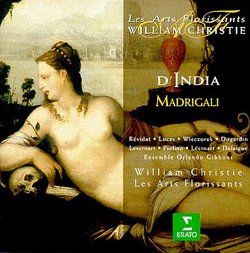Start Here! Christie is Second to None
Giordano Bruno | Wherever I am, I am. | 09/27/2008
(5 out of 5 stars)
"Listening to any other performance of the eccentric madrigals of Sigismondo d'India (1582-1628) - even the recordings by Ensemble La Venexiana - one might be tempted to ask the old question; "What's all the hubbub, bub?" After all, d'India was regarded as bizarre to the extreme by his contemporaries, a composer more interested in outdoing others, Michelangelo Rossi in particular but even the great Monteverdi, than in fulfilling his own great musical promise. His greatest esteem was earned as a performing singer rather than as a composer, and after a reasonably stable residency at the court of Savoy for twelve years, he spent the rest of his life singing here and there in Roma and North Italy. Many of his madrigals, especially the polyphonic ones, seem in the performances of most ensembles to be squarely in the technical language of Monteverdi and even of earlier composers such as Marenzio.
Whatever doubts you may have about d'India's stature as a radical innovator will disappear by the third or fourth track of this performance by Les Arts Florissants. Every note of these 23 madrigals and semi-operatic duets becomes floridly passionate under the baton of William Christie. D'India's drama is achieved by contrasts, by truly unforeseen progressions and voice leadings, by enormous and sudden pauses and changes of dynamic. I don't think Christie is inventing these effects; I think he has just perceived their obvious presence in the music, perhaps for the first time since d'India himself sang to the gentry of Modena and Ferrara. Christie has the core of singers and instrumentalists that can actualize his interpretive insights: eight superb singers mostly pirated from France, spot-perfect continuo built around his own harpsichord, and for this recording one of the most polished viol da gamba ensembles, Les Violes Orlando Gibbon, to fill out the soundscape.
The madrigals here are Christie's selection from all eight of d'India's published books of madrigals and all five of his publications of 'Musiche a Una e Due Voci,' essentially seconda prattica monodies. Such a selection has much to recommend it in the case of d'India, whose eccentricities can become repetitive under less insightful direction.
This is the Sigismondo d'India recording to have. Sell or give away any others; once you hear this one, you won't need them any more."


 Track Listings (23) - Disc #1
Track Listings (23) - Disc #1